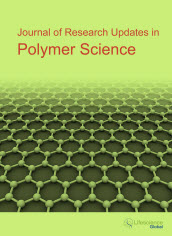jrups
Abstract : Novel Polycarbonates via Phosgenation of Unsaturated Diols
|
|
Abstract: A new interesting class of linear unsaturated polycarbonates based on methyl- cyclohexanone and 4-tert. butyl- cyclohexanone moieties has been synthesized. An interfacial phosgenation technique carried out at ambient temperature was used for the synthesis of these polycarbonates. The resulting polycarbonates were characterized by elemental analyses, infrared spectroscopy,1H nuclear magnetic resonance spectral analyses, viscometry, differential scanning calorimetry and thermogravimetric analysis measurements. All the polycarbonates were soluble in polar solvents like dimethylsulphoxide and sulphuric acid. The crystallinity of some selected polycarbonates was examined by X-ray analysis. In addition, the morphology of selected examples of the polycarbonates was examined by scanning electron microscopy. Keywords: Characterization, Synthesis, polycarbonates, Polycondensation, Unsaturated Diols.Download Full Article |
Abstract : Molecular Characteristics of Chitosan and Structure of its Films Formed from Water Solutions of Acetic and Hydrochloric Acids
|
|
Abstract: Molecular characteristics of chitosan in diluted water solutions of acetic and hydrochloric acids were studied by viscometry, dynamic light scattering, and thin layer chromatography. Chitosan molecules were found to undergo destruction in the solutions of hydrochloric acid and its mixtures with acetic acid. The structure of the chitosan films cast from these solvents was studied by DSC, TGA, and SEM. As shown by electron microscopic data, all the films had an amorphous-crystalline structure but the films prepared from chitosan solutions in diluted hydrochloric acid were characterized by a higher degree of crystallinity. It was supposed that a lower molecular mass of chitosan molecules in the hydrochloric acid solutions results in more extended conformations providing a higher capability of self-organization and formation of regular supermolecular structure. The difference in crystal modification in structure of the films cast of these acids was observed. It was found that the films prepared from the mixtures of acids had a spherulite structure and the crystal modification like ones cast from hydrochloric acid, but with a lower degree of crystallinity. Keywords: Chitosan, water solutions of acids, viscosity, destruction, mixtures of acids solutions, chitosan film structure.Download Full Article |
Abstract : ACM/Hindered Phenol Hybrids: A High Damping Material with Constrained-Layer Structure for Dynamic Mechanical Analysis and Simulation
|
|
Abstract: Due to the strong hydrogen bonding interactions, hindered phenol 3,9-bis[1,1-dimethyl-2{β-(3-tert-butyl-4-hydroxy-5- methylphenyl)propionyloxy}ethyl]- 2,4,8,10-tetraoxaspiro[5,5]-undecane (AO-80) demonstrated a remarkable damping effect when it was hybridized with acrylic rubber (ACM). The loss factor of ACM could be largely increased and the position of loss peak could be regulated by controlling the content of the hindered phenol. This kind of high damping hybrids can be used as the laminated layer of sandwich beam for vibration control. Instead of the traditional method ASTM E756-98, a new method based on dynamic mechanical analyzer (DMA) was developed to characterize the damping behaviors of ACM/AO-80 laminated beam. Testing results demonstrated that DMA can reflect the variation of damping behaviors of sandwich beams with various factors effectively, and a theoretical model established here was used to explain the damping behaviors. Based on this model, by means of adjusting the content of AO-80, a high damping ability for the sandwich beam could be obtained at appointed temperature during a wide frequency range. Keywords: Damping behavior, Hindered phenol, Loss peak, Simulation.Download Full Article |
Abstract : Physical Properties of Polyacrylamide/Polyvinylalcohol Silica Nanocomposites
|
|
Abstract: In this paper, samples of Polyacrylamide (PAAm) nanosilica nanocomposites were prepared having different concentration of nanosilica (0.125, 0.25, and 0.5). Polyacrylamide (PAAm) and poly (vinyl alcohol) (PVA) were blended with different ratio (3/1, 1/1, 1/3) using solution-cast technique. The prepared films were characterized by Fourier transform infrared (FTIR), X-ray diffractions (XRD) and scanning electron microscopy (SEM). FTIR spectra showed the presence of hydrogen bonding between–CONH2 groups in PAAm and –OH group in PVA and confirm the hydrophilic nature of the blends. X-ray diffractions shows the presence of a strong broad peak centered at 22º (2θ) confirms the amorphous nature of silica which is supposed to be the characteristic of SiO2. The results obtained from different experimental techniques were supported by SEM image analysis. The thermal stability of the nanocomposites enhanced by increasing the silica content in the blend. The DC electrical conductivity was studied for all prepared samples. It was found that the conductivity increase by increasing silica content as well as, increased by increasing the wt% of PVA. Keywords: Polyacrylamide (PAAm), Polyvinylalcohol (PVA), Nanosilica SiO2, Blend, Thermal stability TGA and Electrical conductivity.Download Full Article |






















